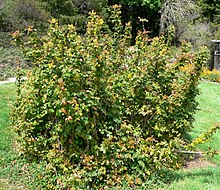| Berberis pinnata | |
|---|---|

| |
| Scientific classification | |
| Kingdom: | Plantae |
| Clade: | Tracheophytes |
| Clade: | Angiosperms |
| Clade: | Eudicots |
| Order: | Ranunculales |
| Family: | Berberidaceae |
| Genus: | Berberis |
| Species: | B. pinnata |
| Binomial name | |
| Berberis pinnata Lag. | |
| Subspecies | |
| |
| Synonyms | |
| |
Berberis pinnata is a species of shrub in the barberry family. Common names include California barberry, wavyleaf barberry, and shinyleaf mahonia. It is similar to the Oregon-grape (Berberis aquifolium), and is sometimes called the California Oregon-grape.
It is native to the west coast of North America from British Columbia to Baja California, where it occurs in forest, woodland, chaparral, and other habitat.
Description
Berberis pinnata is a dark green bush which resembles holly with its serrated leaves. It has one to two inch long clusters of small yellow flowers. The fruit is a purple berry with many seeds 6–7 millimeters in size.
Taxonomy
Berberis pinnata was given its first scientific description and named by Mariano Lagasca in 1816. As part of the botanical debate over the correct classification of species it was placed in Mahonia by Friedrich Karl Georg Fedde as Mahonia pinnata in 1901. Though scientific disagreement continues, as of 2023 the majority of botanical sources list this species in Berberis.
Names
Mahonia is named for Bernard McMahon (1775-1816), an American horticulturist. Pinnata means 'set in two opposite rows' or 'pinnate', and is a reference in this case to the arrangement of the leaflets.
Uses
The Berberis pinnata fruits have also been used to produce purple dye. The shrub is used in landscaping as an ornamental plant. Songbirds eat the berries.
Conservation
One subspecies of this plant is very rare and is federally listed as an endangered species. It is known only from Santa Cruz Island, one of the Channel Islands of California, where it is known from 13 or fewer individuals.
References
- ^ "Berberis pinnata Lag". Plants of the World Online. Royal Botanic Gardens, Kew. Retrieved 7 December 2023.
- NatureServe (2023). "Mahonia pinnata". Arlington, Virginia. Retrieved 7 December 2023.
- ^ Van Atta, S. (2009). The Southern California Native Flower Garden: A Guide to Size, Bloom, Foliage, Color, and Texture. Gibbs Smith: Santa Barbara.
- ^ Whittemore, Alan T. (5 November 2020). "Berberis pinnata - FNA". Flora of North America. Retrieved 7 December 2023.
- WFO (2023). "Berberis pinnata Lag". World Flora Online. Retrieved 7 December 2023.
- ^ Gledhill, David (2008). "The Names of Plants". Cambridge University Press. ISBN 9780521866453 (hardback), ISBN 9780521685535 (paperback). pp 248, 303
- Center for Plant Conservation Archived 2010-12-15 at the Wayback Machine
External links
| Taxon identifiers | |
|---|---|
| Berberis pinnata |
|
This Berberidaceae article is a stub. You can help Misplaced Pages by expanding it. |